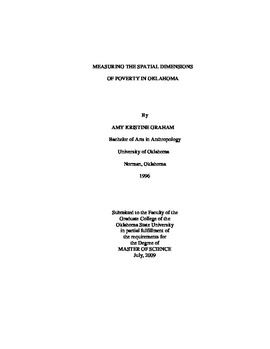| dc.contributor.advisor | Comer, Jonathan | |
| dc.contributor.author | Graham, Amy Kristine | |
| dc.date.accessioned | 2014-04-15T21:46:41Z | |
| dc.date.available | 2014-04-15T21:46:41Z | |
| dc.date.issued | 2009-07-01 | |
| dc.identifier.uri | https://hdl.handle.net/11244/9036 | |
| dc.description.abstract | This study utilizes exploratory spatial data analysis (ESDA), global, and local regression modeling in order to better understand the spatial distribution of poverty across Oklahoma, as well as the underlying factors that influence it in various parts of the state. Geographically weighted regression (GWR) is used to highlight local variations in the poverty rate at both the county and Census tract levels. Variables pertaining to demographics, employment, county/tract characteristics, and federal program spending are examined to assess how the influence of these factors over poverty varies throughout the state. Using a global regression technique, county and tract level models reveal that among the variables that most influence poverty in Oklahoma are the percentage of people who lack a high school diploma, the percentage of female-headed households, per capita income, and the percentage of people employed in primary industries. However, global regression modeling assumes that the influence of these variables is constant across space. Contrary to this assumption, GWR modeling demonstrates that significant local variation in the influence of these factors does indeed exist at both the county and tract level. For example, the lack of a high school diploma is most influential among the northeastern most counties of the state, and in the southern and central regions at the tract level. County level models that included variables pertaining to federal program spending revealed that there are some areas of the state where increases in funding also signal an increase in the poverty rate, especially in the southeast corner of the state where poverty rates are higher overall. However, these county level models must be interpreted with caution as the relatively small sample size of 77 counties hinders GWR's ability to produce a statistically significant model. What is clear is that antipoverty programs should be designed with these local variations in mind in order to better target poverty in specific areas of the state. | |
| dc.format | application/pdf | |
| dc.language | en_US | |
| dc.publisher | Oklahoma State University | |
| dc.rights | Copyright is held by the author who has granted the Oklahoma State University Library the non-exclusive right to share this material in its institutional repository. Contact Digital Library Services at lib-dls@okstate.edu or 405-744-9161 for the permission policy on the use, reproduction or distribution of this material. | |
| dc.title | Measuring the spatial dimensions of poverty in Oklahoma | |
| dc.type | text | |
| dc.contributor.committeeMember | Bays, Brad Alan | |
| dc.contributor.committeeMember | Ge, Jianjun | |
| osu.filename | Graham_okstate_0664M_10404.pdf | |
| osu.college | Arts and Sciences | |
| osu.accesstype | Open Access | |
| dc.description.department | Department of Geography | |
| dc.type.genre | Thesis | |
